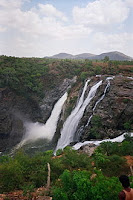 This is not a new concept. Leaders in India have thought over this for over hundred years. No conclusive and accepted solution by all, has yet been found though. Many of the national leaders accepted Hindi as the contact language for Indians. There had been resistance to this specially from southern states.
This is not a new concept. Leaders in India have thought over this for over hundred years. No conclusive and accepted solution by all, has yet been found though. Many of the national leaders accepted Hindi as the contact language for Indians. There had been resistance to this specially from southern states. Major reasons for the resistance had been due to fear that people whose Hindi is mother tongue would grab all jobs in various services at the centre. Southern states and Bengal had and still is proficiency in English. All competitive examinations use English language. This gives upper hand for competitors from this region. No one would like to loose the advantage. Later with spread of internet and information availability, English gained further preference. However, if we check the population knowing English, it shows that not more than 5% population is comfortable with English. However these people are in the decision making process and hence are in a position to brutally force their opinion on remaining 95% population, specially when there is no possibility of 95% population accepting any one common language. Lack of unanimous ness on a common language among others gave strength to people who force English on a large population. The only disadvantage with English is it is found difficult by the 95% population to learn and hence cannot be accepted as a common language. On other hand there is no need to know English by almost all population in their work. Therefore, English cannot be a common language for India. Similarly, no other Indian language would be accepted by all unaminously. This is a trivial situation.
Management science states that there is no problem for which there is no solution. There is a great need to address this obstacle from the base. The first resistance to any other Indian language is because of different scripts for languages. Among all the script is use in India, Devnagari script is used by different languages. Hindi stands first in this row. Marathi, Konkani and Nepali languages do use this script. Although Devnagari script used for Hindi and other languages i. e. Marathi, Konkani and Nepali had been different the differences have been got over and a common script is evolved now. Consonants and vowels used in almost all Indian languages are common. Languages like Tamil, Urdu and Kashmiri do have a slight difference. This difference is not much and can be easily resolved. Punjabi, Bengali, Oriya, Assamese language script is similar to Devnagari. Southern states also have started learning Devnagari. Hence, it would be easy to make Devnagari script acceptable by 100% population. This should be the first step towards final aim of building a common language for communication among all Indians.
Some might take objection to Devnagari as computer keyboard is some what tedious for use of Devnagari. Here basically we must accept that keyboard is designed taking in to consideration English language. All other languages have to compromise. Even French, Germans, Russians, Chinese, Japanese, Koreans and many others have compromised on it. Therefore, this cannot be considered as an obstacle. Fortunately English keyboard has 26 keys for letters and with 'Shift' key this becomes 52. Devnagari script has 52 letters. However vowels use 2 different symbols. Hence it becomes 64. If research is made to overcome this problem the existing keyboard can easily be used for Devnagari script. Experts should work in this field and make Devnagari script acceptable by all Indians.
Mumbai is the only metropolitan city in India who has solved common language problem. Mumbai has developed its own language mixing Hindi, Marathi, Gujarati, Kannada, Telugu, Malayalam, Tamil and English. This is popularly known as Bombaia Hindi. Other metropolis like Kolkota and Chennai failed to evolve a solution, basically because of high resistance of locals. Whoever migrated to these cities were more or less forced to learn local language.
Example of Mumbai is quite encouraging. Indians should work on a common script first and then build a national language. This may take say 20 or 50 years. However, this cannot be considered as a long period of time when life of nation is considered.











No comments:
Post a Comment